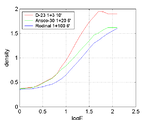Hi Bernard, yes it was Fuji HR-T. Rodinal 1:100, I almost always do 6-7 minutes at around 70F.
Even better, here is a comparison I wrote up on my old blog, compared with Delta 100:
https://valdostafilm.blogspot.com/20...-feb-2016.html
Hi Bernard, yes it was Fuji HR-T. Rodinal 1:100, I almost always do 6-7 minutes at around 70F.
Even better, here is a comparison I wrote up on my old blog, compared with Delta 100:
https://valdostafilm.blogspot.com/20...-feb-2016.html
" So, the cool thing about 18x24 film is, that I can slice it into 4 sheets of 9x12cm. And I have a lot of 9x12 gear. Lots of holders and a stainless steel development cage, that I can dunk into lock&lock tanks to develop. And for that, a developer that keeps longer is useful."
YES!! I do exactly the same thing, I have many metric sized holders, for my European cameras. Easy Peasy to cut 18x24cm to four 9x12cm, and no film waste.
I have both the 240 Symmars and 240 Heliars. I prefer your photo #1 myself as the image is very sharp, as I expect with Symmars. But for landscapes and focus with bokeh evident, I much prefer the Heliar, like my Xenars they are a pinch smoother in rendering, very pleasing to my eye. So IMO both are good to have!
Flikr Photos Here: https://www.flickr.com/photos/18134483@N04/
“The secret of getting ahead is getting started.”
― Mark Twain
At the same places you buy the bigger formats. 15x30 and 13x18 should even need less cuts.
I've never seen 4x5 xray film for sale, but I was given a few boxes of 5x7 one time. Last year I bought 1000 sheets of 8x10 and have been cutting them down to 4x5, for a total cost of $0.11 per sheet. Rodinal at 1:100 is very economical. I use 1200 mL for 12 sheets, or 1 mL Rodinal each, so about $0.03 per sheet for developer. Under 15 cents per shot all in!
Shooting with my RB Graflex I've shot 36 sheets in a day. $5.40 for 36 shots is cheaper than 35mm film these days...
So I have this box of 24x30cm Carestream MIN-R EV mammo film, that I grabbed because it was cheap (33€ IIRC). After the purchase, I realized that it has emulsion on both sides, and nobody else uses this for photography as far as I know. And I saw what, e.g., Corran could do with Fuji HR-T. But maybe MIN-R EV is OK; only poor craftsmen blame their tools.
As a first step to make the best use of my MIN-R EV, I made dev tests following exposure through a Stouffer step wedge (31x0.1D). These seem to be popular among participants on this forum.
- D-23 1+3 10' 23°C
- Ansco 30 1+20 21°C
- Rodinal 1+100 20°C
The Ansco 30 and Rodinal devs appear to provide a dynamic range of ~1.4 in logE, just short of 5 stops. The density span of ~1.2 is ok for approx grade 2 silver printing. The D-23 dev is too contrasty and has a strange behavior near Dmax; needs to be iterated.
Question to experienced practitioners. Is this close to the best one can expect from X-ray film? Or, could I obtain significantly better dynamic range --suitable for outdoors scenes on a sunny day-- from another film, Fuji HR-T or UM-MA?

Mammo films have emulsion on one side only, as far as I know!
"I believe there is nothing more disturbing than a sharp image of a fuzzy concept!" (Ansel Adams)
https://philippe.grunchec-photographe.over-blog.com/
Not all of them. Carestream declares Min-R 2000 Plus as Mamography film. Still if you look at the datasheet, it specifies coating on both sides.
The funny part is, I bought my Carestream films knowing that they are double coated (The reason I looked in the data sheets was that in their commercial advertisments they mention coating with two emulsions, coarse and fine, but not if these are applied onto the same side of the support.) and only later found out Carestream sells some of them as Mamo film. I am wondering why. Can it be they just stopped production of Mamo film, or never purchased it from Kodak, and simply sell double side coated lying about how it is super high resolution?
Last edited by Eugen Mezei; 29-Jun-2025 at 08:18.
Using an orange filter on green-latitude x-ray...
YouTube Channel: https://www.youtube.com/user/andy8x10
Flickr Site: https://www.flickr.com/photos/62974341@N02/
Instagram: https://www.instagram.com/andrew.oneill.artist/
About the cutting. I have (multiple) life time supply of X-ray film, mamo and regular. The smallest size is 13x18 cm - X-ay is about 1:1 image so regular film is big (I don't know about the x-ray dental film) so is ideal for big camera starting from 5x7 and up.
In the process of testing developers (and being stingy) I didn't like wasting a whole sheet just for an exposure test so I started chopping off the film and the easiest thing to do - chop it to medium format (120 film). I t worked so well that now I am using it everywhere. After the medium format I discovered that I can easily use it on long dead format from Kodak (116, 122, 127, etc) so now I have bunch of "dead" cameras coming alive. Of course I can cut for any kind of portable plate camera 9x12, 10x15 (Trona, Ideal, Avus)
For now I settled on Pyro-501 (home made 4 years ago). 0.2ml/75ml water - 30 minutes rotary
https://www.flickr.com/photos/114856...posted-public/
This is from a Zeiss Box Tengor
Bookmarks